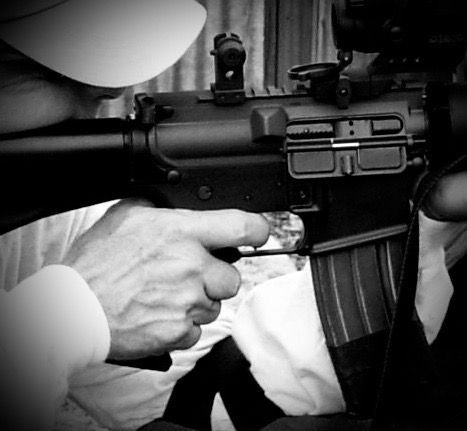 |
Last week we covered the aspects of trigger manipulation required to fire an accurate shot. This week we’re looking at what happens after the shot is fired. And make no mistake, what you do with the trigger after the shot is just as important as the action prior to the shot.
The fundamentals of firing an accurate shot are Aim, Hold, Press and Follow-through. A smooth press is required to hit accurately. Anticipating the recoil, tensing up the muscles in anticipation will jerk the sights off target prior to the bullet exiting the barrel. This anticipation can occur when you’re pressing the trigger smoothly, but is most noticeable when you jerk or slap the trigger, saying to yourself, “I’m going to fire now.”
So, we press the trigger smoothly and the shot breaks. Now, it’s time to follow through. Recover from the recoil, reacquire the sight picture and reset the trigger. You’re preparing to fire again. Remember, the threat decides when the shooting is done. We don’t know how many shots will be required. Follow-through, getting ready to shoot again, must become habit. Resetting the trigger is the key to firing multiple shots accurately and efficiently.
Most shooters, even experienced ones, remove their finger from the trigger as soon as the shot breaks. In order to fire again – pistols rounds usually take multiple hits to stop the threat – the finger has to get back to the trigger, take out any slack and start another press. This wasted movement consumes time. Plus, people get into a rush – “I need to shoot again now!” – so they’ll slap or jerk the trigger and anticipate the shot which is not going to be accurate. By trying to shoot fast you’re actually slower – time is lost – and less accurate.
The shot fires. Keep pressure on the trigger, holding it to the rear. Recover from the recoil and obtain a new sight picture. Now, reset the trigger. Slowly release the trigger, letting it travel forward until you feel the internal components “click” or “reset.” At this point you hold, and ask yourself, “Do I need to fire again?” If yes, you’re ready to begin another controlled press. (Some pistols will require you to remove a small amount of slack even after resetting.
This trigger work is slow, especially in the beginning or when trying to work it into your existing routine. Verbalizing will help. “Front sight, pressss…”. After the shot, keep the trigger held to the rear. Recover from the recoil. “Front sight, reset.” Ask yourself, “Do I need to fire again?” If no, come off the trigger, off target into a low ready position and scan. Eventually, with proper repetition this sequence becomes habit. Until then, verbalizing will help.
Manipulating the trigger before and after the shot is the key to putting multiple shots accurately on target efficiently. Keep in mind, there’s a difference between effective and efficient. Effective gets the job done, but maybe not in a timely fashion. When learning trigger manipulation, both pre- and post- shot, you may have to take a step or two back, slowing down to get it right. Eventually, this will make you more efficient. In other words, you’re better equipped to stop the threat. It’s worth the effort.
Tiger McKee is director of Shootrite Firearms Academy, which is celebrating its twenty-fifth anniversary. He is the author of The Book of Two Guns, AR-15 Skills and Drills, has a regular column in American Handgunner and makes some cool knives and custom revolvers. Visit Shootrite’s Facebook page for other details.